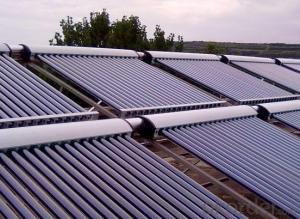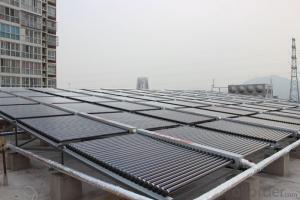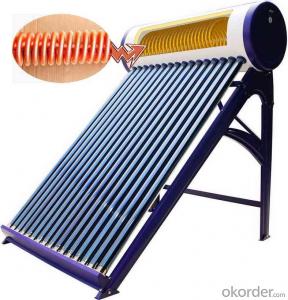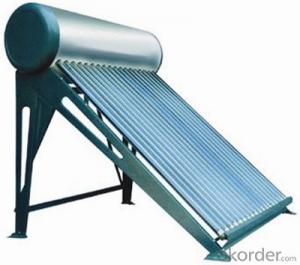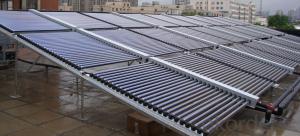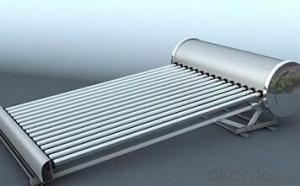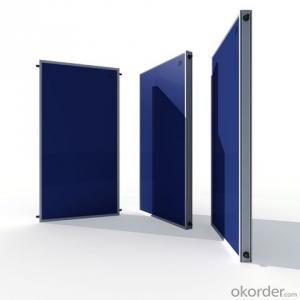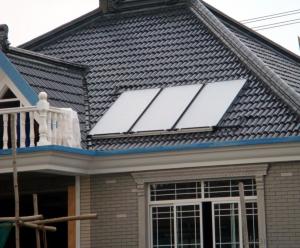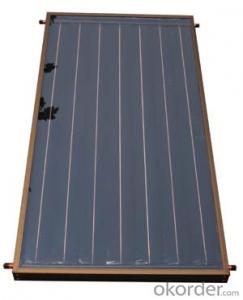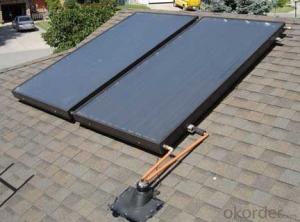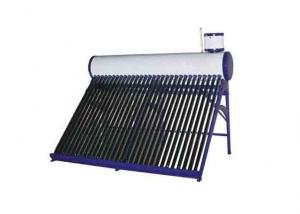Coper Heat Pipe Solar Water Heater System
- Loading Port:
- China main port
- Payment Terms:
- TT OR LC
- Min Order Qty:
- 1 set
- Supply Capability:
- 6000 set/month
OKorder Service Pledge
OKorder Financial Service
You Might Also Like
Introduction of Non-Pressure Solar Water Heater:
Non-pressure Solar Heater is one of the most economical solar water heating device with pretty high efficiency at the same time. It consists of hot water storage tank, solar vacuum tubes with mouth plug in storage tank, and bracket supporting tank and tubes.When cold water in evacuated tubes is heated with solar irradiation, as the specific gravities of hot water and cold water are different, hotter water goes upward to storage tank and colder water goes downward to glass tubes. through this continuous circulation, the cold water in storage tank will be gradually heated till sunset.
Specialty:
1. High thermal performance and working temperature: the heat exchanging rate even in winter can up above 55%.
2. Heat collecting efficiency is at least 20% above common solar systems.
3. Work in all day and all season: no matter any corner of the world, this system can work well even -40℃ to avoid the tube freezing problem.
4. Reliability: No water following through the tube, so water scale can not generate and tube cracks could be avoided, the system still can keep working even with some damaged tubes.
5. It can connect with water tap and work automatically with pressure0.6Mpa, bring enjoyable washing experience.
6. Safety: P/T valve would release pressure and temperature to protect tank..
Technical Specification:
1. Outer tank material: SUS304 stainless steel or powder coated color steel
2. Inner tank material: 1.2mm thick SUS304 food grade stainless steel ( Optional material SUS316L)
3. Vacuum tube material: borosilicate glass 3.3; AL-SS-CU absorb coating, with copper heat pipe inside
4. Frame material: 1.2mm thickness stainless steel
5. Insulation material: 55mm thickness polyurethane
6. Suitable for mains pressure water(up to 8 bar/116psi)
7. Easy plug-in installation
8. Install the T/P valve on the pressurized tank
9. Seal material: Stabilized High Temperature Silicon
Outer tank material: SUS304 stainless steel or powder coated color steel
Inner tank material: 1.2mm thick SUS304 food grade stainless steel ( Optional material SUS316L)
Vacuum tube material: borosilicate glass 3.3; AL-SS-CU absorb coating, with copper heat pipe inside
Frame material: 1.2mm thickness stainless steel
Insulation material: 55mm thickness polyurethane
Suitable for mains pressure water(up to 8 bar/116psi)
Easy plug-in installation
Install the T/P valve on the pressurized tank
Seal material: Stabilized High Temperature Silicon
19. Vacuum Tube | 20. Size (mm) | 21. Φ47*1500 / Φ58*1800 / Φ70*2100 | |||||
22. Tube (pcs) | 23. 10 / 12 / 15 / 18 / 20 / 22 / 24 / 30 / 36 / 42 | ||||||
24. Material | 25. Borosilicate 3.3 glass, magnetron spluttering selective coating | ||||||
26. Coating | 27. Single-target AL-N/AL or Three-target AL/N-Cu-SS | ||||||
28. Water Tank | 29. Capacity | 30. 80L ~ 500L for hot water storage tank | |||||
31. Inner tank | 32. Food-grade stainless steel SUS304-2B / SUS316 | ||||||
33. Insulation | 34. High-density polyurethane foam with 70~80 hour heat preservation | ||||||
35. Tank shell | 36. Food-grade stainless steel SUS304-2B | ||||||
37. Bracket | 38. Shaped strong aluminum alloy structure adaptable for flat or slope roof | ||||||
39. Accessories | 40. Anti-aging silicon seals, Dustproof seals, Air-vent cap, Stainless screws | ||||||
41. Auxiliary Devices | 42. Assistant tank, Intelligent controller, Electrical heater, Magnesium anodes | ||||||
43. Tilt Angle | 44. 25 ~ 50° | ||||||
45. Water Output | 46. 45 - 95°C | ||||||
47. Hail Resistance | 48. Φ25mm diameter | ||||||
49. Model Number | 50. Solar Vacuum Tube | 51. Tank 52. Liter | 53. System 54. Liter | 55. Container Loading Qty /sets | |||
56. Size /mm | 57. Qty /pcs | 58. 20GP | 59. 40GP | 60. 40HQ | |||
61. VNS-58SA12-100 | 62. Φ58*1800 | 63. 12 | 64. 100 | 65. 132 | 66. 58 | 67. 119 | 68. 140 |
69. VNS-58SA15-130 | 70. 15 | 71. 130 | 72. 170 | 73. 54 | 74. 108 | 75. 131 | |
76. VNS-58SA18-150 | 77. 18 | 78. 150 | 79. 198 | 80. 43 | 81. 86 | 82. 105 | |
83. VNS-58SA20-170 | 84. 20 | 85. 170 | 86. 223 | 87. 40 | 88. 80 | 89. 97 | |
VNS-58SA24-200 | 24 | 200 | 263 | 35 | 70 | 85 | |
VNS-58SA30-250 | 30 | 250 | 329 | 28 | 56 | 68 | |
VNS-58SA36-300 | 36 | 300 | 395 | 23 | 47 | 57 | |
Product Show
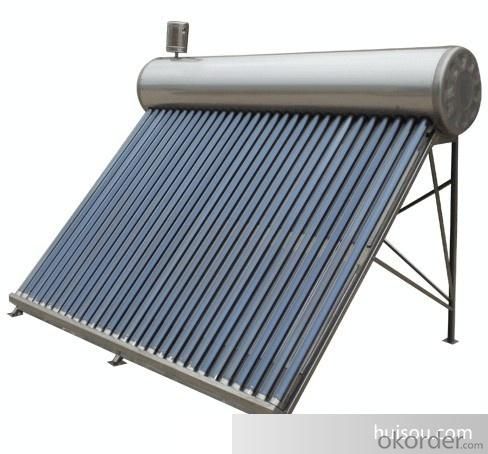
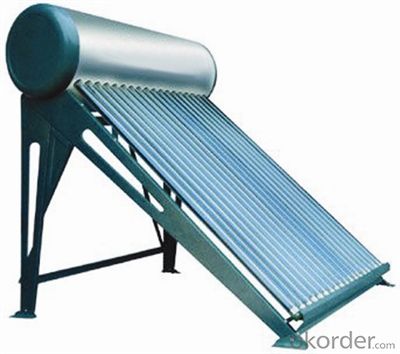
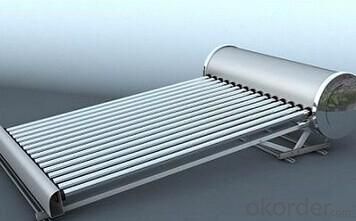
Our Services
1. OEM service
2. Warranty: 5 years
3. Considerable after sale service
Color steel Compact pressure Thermal solar heater
FAQ:
1. What’s the delivery time?
10 days after receiving deposit.
2. How long is the warranty?
5 years for whole system, 1 year for accessory
3. What’s your production capacity?
6000sets/month
4. What’s the MOQ?
1 set.
5. What’s your payment term?
Container: 30% T/T in advance for deposit, 70% T/T before shipment for fist order.
70% T/T after seeing copy of B/L from second order
Sample: 100% T/T in advance
Other choices: L/C at sight.
6. What certifications do you have?
CE, SOLAR KEYMARK, SRCC and etc.
- Q:Can solar collectors be used for heating office buildings?
- Yes, solar collectors can be used for heating office buildings. Solar thermal collectors can capture and convert solar energy into heat, which can then be used for space heating in office buildings. This can help reduce the reliance on traditional heating systems and decrease energy costs while promoting sustainability.
- Q:How do solar collectors perform in coastal areas?
- Solar collectors perform well in coastal areas due to the abundance of sunshine and the relatively cooler climate. The proximity to the ocean helps regulate temperature and reduce heat stress on the collectors, while the strong coastal winds can help keep them clean from dust and debris. Additionally, the availability of open space in coastal regions allows for efficient placement of solar panels, maximizing their exposure to sunlight and optimizing their performance.
- Q:Can solar collectors be used for heating warehouses?
- Yes, solar collectors can be used for heating warehouses. Solar thermal systems, such as flat plate or evacuated tube collectors, can capture and convert solar energy into heat. This heat can then be used for space heating in warehouses, providing a sustainable and cost-effective alternative to traditional heating methods.
- Q:Are there any disadvantages to using solar collectors?
- Yes, there are a few disadvantages to using solar collectors. Firstly, the initial cost of installing solar collectors can be quite high, making it less affordable for some individuals or businesses. Additionally, solar collectors require a significant amount of space for installation, which may limit their use in densely populated areas. Furthermore, solar collectors are dependent on sunlight, so their efficiency can be affected by variations in weather conditions or seasonal changes. Lastly, the manufacturing process of solar collectors can have environmental impacts, particularly if not properly recycled or disposed of at the end of their lifespan.
- Q:Can solar collectors be used in fuel cell power plants?
- Yes, solar collectors can be used in fuel cell power plants. Solar collectors can generate electricity by converting sunlight into direct current (DC) electricity, which can then be used to power fuel cell systems. The combination of solar collectors and fuel cells can provide a sustainable and efficient source of electricity for power plants.
- Q:Can solar collectors be used in combination with other renewable energy sources?
- Yes, solar collectors can be used in combination with other renewable energy sources. This is known as hybrid renewable energy systems. By combining solar collectors with other sources like wind turbines or hydroelectric power, the overall energy production can be increased and made more reliable. This integration allows for a more balanced and efficient renewable energy solution.
- Q:Can solar collectors be used for heating theaters and concert halls?
- Yes, solar collectors can be used for heating theaters and concert halls. Solar thermal systems can efficiently capture sunlight and convert it into heat energy, which can then be used to provide heating for indoor spaces. By utilizing solar collectors, theaters and concert halls can reduce their reliance on traditional heating systems and lower their energy costs while also contributing to a more sustainable and environmentally-friendly approach to heating.
- Q:Can solar collectors be used for generating electricity on elevators?
- Solar collectors can technically be used for generating electricity on elevators, but there are several factors that need to be considered. Firstly, solar collectors require direct sunlight to generate electricity efficiently. Elevators are usually enclosed within buildings or shafts, which may limit the availability of direct sunlight. Additionally, elevators are constantly moving up and down, which can create shadows and further reduce the exposure to sunlight. Furthermore, solar collectors are typically installed on rooftops or open areas where they can capture maximum sunlight. Mounting them on elevators would require specific engineering and design considerations to ensure that they are properly positioned and oriented to receive adequate sunlight. It would also require additional mechanisms to continuously adjust the position and angle of the solar collectors to optimize their efficiency as the elevator moves. Another challenge is the limited space available on elevators. Solar collectors require a certain surface area to generate a significant amount of electricity, and it may not be feasible to accommodate them on the limited surface area of an elevator. Moreover, elevators have varying power requirements, and the amount of electricity generated by solar collectors may not be sufficient to meet the elevator's needs at all times. This would require the installation of energy storage systems or alternative power sources to ensure a consistent and reliable power supply. In conclusion, while it is technically possible to use solar collectors for generating electricity on elevators, it presents several challenges in terms of sunlight availability, limited space, and varying power requirements. It would require extensive engineering and design considerations to overcome these challenges and make it a viable solution for powering elevators.
- Q:Can solar collectors be used for generating electricity on medical devices?
- Medical devices can utilize solar collectors, such as photovoltaic cells, to generate electricity. These solar collectors directly convert sunlight into electrical energy, providing a renewable source of power. This energy can be used to operate a range of medical devices, including portable monitors, defibrillators, ventilators, and even surgical equipment. By incorporating solar collectors, medical devices can gain independence and sustainability, especially in remote areas with limited access to reliable electricity grids. Furthermore, solar power offers environmental advantages by decreasing reliance on fossil fuels and minimizing carbon emissions. However, it is crucial to consider the specific power requirements of each medical device and ensure that the solar collectors can generate enough electricity to fulfill those needs.
- Q:What is the impact of altitude on solar collector performance?
- The impact of altitude on solar collector performance is that higher altitudes generally lead to increased solar radiation due to thinner atmosphere, resulting in improved performance and higher energy production from solar collectors.
1. Manufacturer Overview |
|
|---|---|
| Location | |
| Year Established | |
| Annual Output Value | |
| Main Markets | |
| Company Certifications | |
2. Manufacturer Certificates |
|
|---|---|
| a) Certification Name | |
| Range | |
| Reference | |
| Validity Period | |
3. Manufacturer Capability |
|
|---|---|
| a)Trade Capacity | |
| Nearest Port | |
| Export Percentage | |
| No.of Employees in Trade Department | |
| Language Spoken: | |
| b)Factory Information | |
| Factory Size: | |
| No. of Production Lines | |
| Contract Manufacturing | |
| Product Price Range | |
Send your message to us
Coper Heat Pipe Solar Water Heater System
- Loading Port:
- China main port
- Payment Terms:
- TT OR LC
- Min Order Qty:
- 1 set
- Supply Capability:
- 6000 set/month
OKorder Service Pledge
OKorder Financial Service
Similar products
New products
Hot products
Hot Searches
Related keywords
